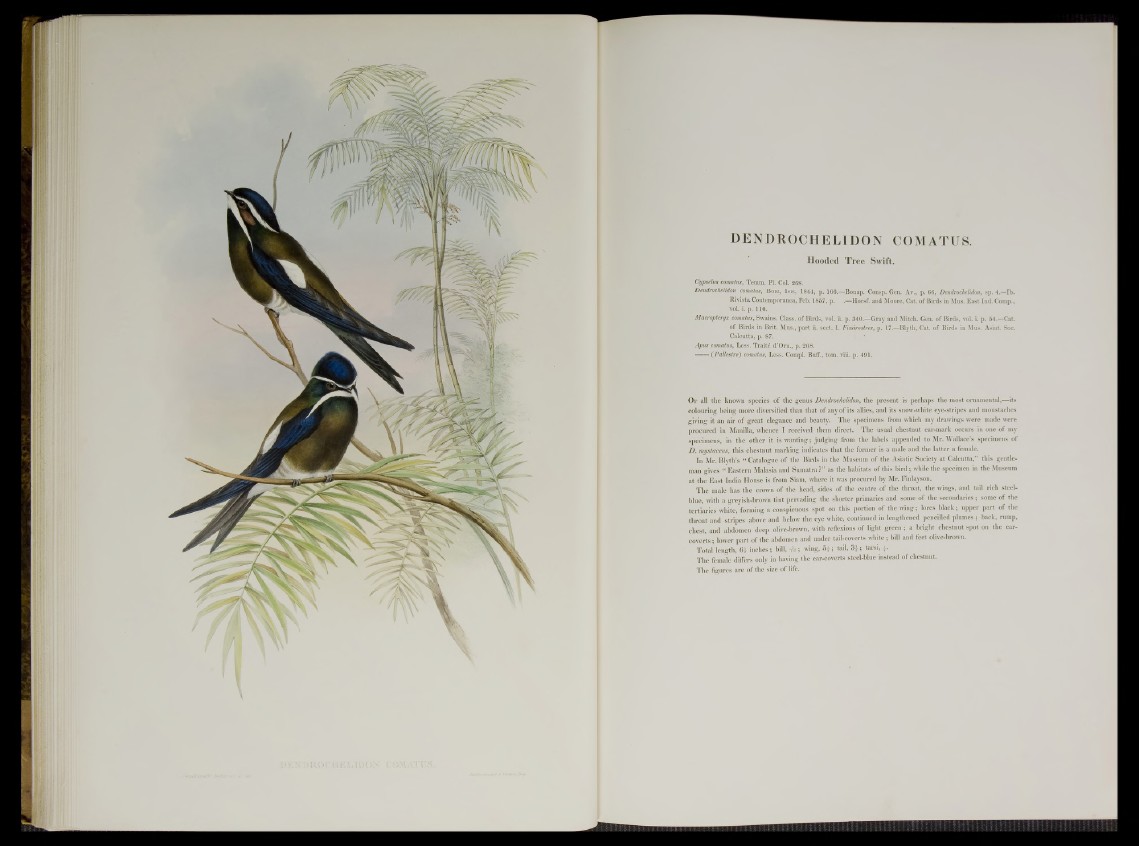
DENDROCHELIDON COMATUS.
Hooded Tree Swift.
Cypselus comatus, Temm. PI. Col. 268.
Dendrochelidon comatus, Boie, Isis, 1844, p. 166.—Bonap. Consp. Gen. Av., p. 66, Dendrochelidon, sp. 4 —lb.
Rivista Contemporanea, Feb. 1857, p. , Horsf. and Moore, Cat. of Birds in Mas. East Ind. Comp.,
vol. 1 p. 110.
Macropteryx comatus, Swains. Class, of Birds, vol. ii. p. 340.—Gray and Mitch. Gen. of Birds, vol. i. p. 54.—Cat.
of Birds in Brit. Mus., part ii. sect. 1. Fissirostres, p. 17.—Blyth, Cat. of Birds in Mus. Asiat. Soc.
Calcutta, p. 87.
Apus comatus, Less. Traité d’Orn., p. 268.
( Pallestre) comatus, Less. Compl. Buff., tom. viii. p. 491.
O f all the known species of the genus Dendrochelidon, the present is perhaps the most ornamental,—its
colouring being more diversified than that o f any of its allies, and its snow-white eye-stripes and moustaches
giving it an air o f great elegance and beauty. The specimens from which my drawings were made were
procured in Manilla, whence I received them direct. The usual chestnut ear-mark occurs in one o f my
specimens, in the other it is wanting; judging from the labels appended to Mr. Wallace’s specimens of
D. mystaceus, this chestnut marking indicates that the former is a male and the latter a female.
In Mr. Blyth’s “ Catalogue of the Birds in the Museum of the Asiatic Society at Calcutta,” this gentleman
gives “ E astern Malasia and Sumatra ?” as the habitats o f this b ird ; while the specimen in the Museum
a t the E a st India House is from Siam, where it was procured by Mr. Finlayson.
The male has the crown of the head, sides of the centre of the throat, the wings, and tail rich steel-
blue, with a greyish-brown tint pervading the shorter primaries and some of the secondaries; some of the
tertiaries white, forming a conspicuous spot on this portion of the wing; lores black; upper p art of the
throat and stripes above and below the eye white, continued in lengthened pencilled plumes ; back, rump,
chest, and abdomen deep olive-brown, with reflexions o f light g r e e n ; a bright chestnut spot on the ear-
co v erts; lower p art o f the abdomen and under tail-coverts white; bill and feet olive-brown.
Total length, 64- inches; bill, -¡V; wing, 5-f-; tail, 3 £ ; tarsi,
T h e female differs only in having the ear-coverts steel-blue instead o f chestnut.
The figures are of the size of life.